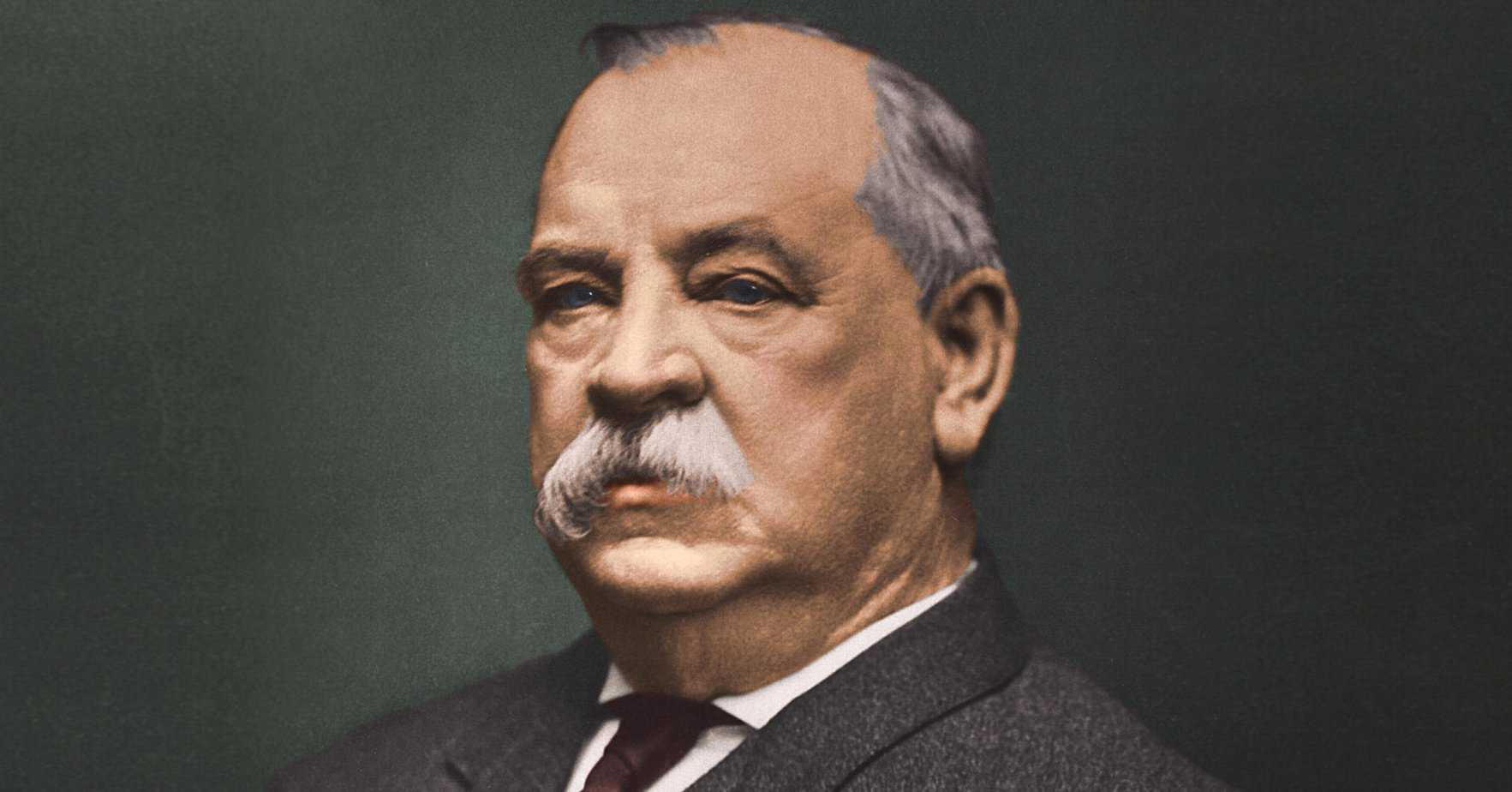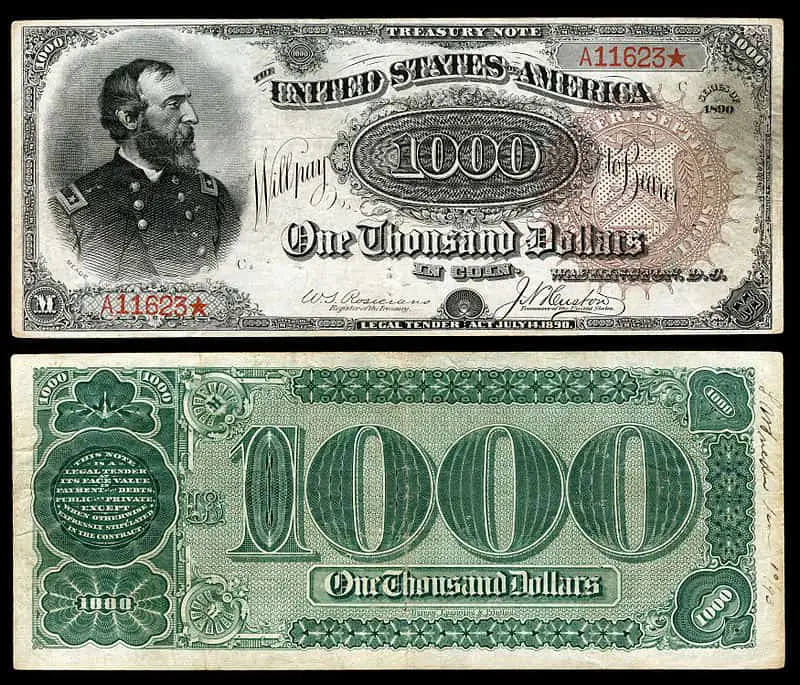Table of Contents
For currency collectors, the thrill of the hunt is just as exciting as the prize itself. And when it comes to rare bills, the hunt can be especially rewarding.
Many factors, including age, condition, and denomination, can make a bill rare. Some rare bills are famous for their unique designs or historical significance. Others are very few, making them highly sought-after by collectors.
Is there a 1000 dollar bill?
The United States has issued $1,000 bills in the past. However, the $1000 bill is a discontinued high-denomination banknote of the United States. It was first issued 1861 during the American Civil War and last printed in 1945. The $1000 bill was discontinued in 1969, along with the $500 bill, due to concerns about counterfeiting and the declining use of high-denomination currency.
The $1,000 bill featured various images on its front side over the years, with the most well-known perhaps being that of President Grover Cleveland. Cleveland’s image was used on the $1,000 bill series of 1928 and 1934. The reverse side usually had a stylized ornamental design.
High-denomination currency, including the $1,000 bill, was last printed on December 27, 1945, and officially discontinued on July 14, 1969, by the Federal Reserve due to ‘lack of use.’ This means that the Federal Reserve and the Department of the Treasury stopped issuing these notes and began taking them out of circulation.
Although not commonly used in daily transactions, these high-denomination bills are still legal tender in the United States, meaning they could be used for purchases. However, because these bills are now rare, collectors often pay more than face value for them.
For example, the Grand Watermelon, a $1,000 bill issued in 1890, is one of the most famous and sought-after $1,000 bills, fetching millions of dollars in auctions.
In today’s society, high-value transactions typically occur electronically, reducing the need for high-denomination currency. The most enormous denomination bill in wide circulation today in the United States is the $100.
The Grand Watermelon Note
The Grand Watermelon Note is a colloquial term used to refer to a specific piece of U.S. currency: the $1,000 Treasury Note issued during the 19th century, specifically in 1890.
Today, $1000 bills are still legal tender but extremely rare. There are only an estimated few thousand $1000 bills in circulation. Collectors or institutions hold most $1000 bills.
The $1000 bill is a fascinating piece of American history. It is a reminder of a time when large currency denominations were more common. The bill is also a testament to the ingenuity of American printers, who created a beautiful and secure note.
Here are some additional facts about the $1000 bill:
- The $1000 bill was the highest-denomination bill ever issued by the U.S. government.
- The $1000 bill was used primarily for large transactions, such as property purchases or investments.
- The $1000 bill was discontinued due to concerns about counterfeiting and the declining use of high-denomination currency.
- Today, $1000 bills are still legal tender but extremely rare.
Who is on the 1000-dollar bill?
The $1000 bill features a portrait of Grover Cleveland on the front. Cleveland was the 22nd and 24th president of the United States. The back of the bill features an image of the Federal Reserve Building in Washington, D.C.

Stephen Grover Cleveland was an American politician and lawyer who served as the 22nd and 24th president of the United States, the only president in American history to serve two non-consecutive terms in office (1885–1889 and 1893–1897).
Early Life: Cleveland was born on March 18, 1837, in Caldwell, New Jersey, to Richard Falley Cleveland and Ann Neal Cleveland. He was the fifth of nine children. Cleveland’s father was a Presbyterian minister, and the family moved several times during Cleveland’s early life. In 1853, when he was 16, his father died, and Cleveland dropped out of school to help support his family.
Career before Presidency: After clerking for a law firm in Buffalo, New York, Cleveland was admitted to the bar in 1859. He then worked as an assistant district attorney and later as the sheriff of Erie County, New York. In 1881, he was elected mayor of Buffalo and gained a reputation for battling corruption and political patronage. The following year, he became governor of New York.
First Term as President (1885–1889): Cleveland, a Democrat, was elected to the presidency in 1884, defeating Republican candidate James G. Blaine. He was known for his honesty, integrity, and opposition to political patronage. His first term was marked by his focus on civil service reform, tariff reduction, and his veto of wasteful congressional spending.
In 1886, Cleveland married Frances Folsom, who was 27 years his junior, in a ceremony in the Blue Room of the White House, becoming the only president to be married in the executive mansion.
Second Term as President (1893–1897): After losing the presidency to Benjamin Harrison in the election of 1888, Cleveland was reelected in 1892, defeating Harrison. An economic depression marked his second term, the Panic of 1893, which led to severe economic hardship for many Americans. He faced criticism for handling the Pullman Strike in 1894 when he sent federal troops to enforce an injunction against the striking workers.
Post-Presidency and Death: After leaving the White House in 1897, Cleveland retired to Princeton, New Jersey, where he worked on his memoirs and was a trustee of Princeton University. He passed away on June 24, 1908, from a heart attack. His death marked the end of an era, as he was the last president to have served in the Civil War.
Legacy: Cleveland’s legacy is mixed, with praise for his honesty, integrity, and commitment to principle but criticism for his handling of economic issues and labor relations. His efforts to reform the civil service and reduce patronage have been praised, while his handling of the Pullman Strike and the economic depression during his second term has been viewed more critically. Despite these criticisms, historians often rank him as a slightly above-average president.
Grand Watermelon Note Design
The front of the note features a portrait of General Meade on the left side, along with intricate designs typical of the period. The note is a “Treasury” or “Coin” note and was initially issued to finance the purchase of silver under the Sherman Silver Purchase Act of 1890.

Front Design: The note’s front features an image of General George Gordon Meade, a Union Army general during the American Civil War, on the left side. The right side showcases a stamp of the US Treasury. The marks indicating the place and year of issue – Washington and 1890, respectively – are also present. The signatures of W. S. Rosecrans, Register of the Treasury, and E. H. Nebeker, Treasurer of the United States, are affixed. The red serial number consists of a letter, five numbers, and an asterisk in the note’s lower-left and upper-right corners. The note is bordered by a decorative frame, with “Treasury Note” written on top and “Legal tender act July 14, 1890” at the bottom.
Back Design: The back of the note displays a large denomination mark of “1000.” The zeros are shaped like watermelons, hence the nickname “Grand Watermelon Note.” The inscription beneath the denomination affirms the note’s status as legal tender for all debts, public and private, except when contracts specifically indicate otherwise.
The nickname “Grand Watermelon” comes from the large green zeros on the back of the note. These zeros are designed to resemble watermelons with their green color and wavy, ridged patterns.
The other designs on the back of the note, such as the Treasury Seal and the words “One Thousand Dollars,” also contribute to the watermelon-like appearance of the note.
The nickname “Grand Watermelon” is a playful one, but it is also a fitting one. The large green zeros on the back of the note are undoubtedly eye-catching and resemble watermelons. The nickname is also a reminder that the Grand Watermelon Note is a rare and valuable piece of American history.
Here is a quote from Q. David Bowers, a well-known numismatist, about the nickname “Grand Watermelon”:
“The nickname ‘Grand Watermelon’ is one of the most apt and enduring in American numismatics. It is a perfect description of the large green zeros on the back of the note, which do indeed resemble watermelons.”
Grand Watermelon Rarity and Value
This note is considered one of the rarest and most sought-after pieces of U.S. currency. It’s estimated that only a handful of these notes exist today. Many of them are housed in museums or private collections.
Because of their rarity, Grand Watermelon Notes are pretty valuable. The exact value of a Grand Watermelon Note can vary depending on its condition and the specific auction market at the time of sale. However, they have been known to sell for over $3 million at auction, making them one of the most expensive pieces of paper currency ever sold. In January 2014, a Grand Watermelon Note was sold at auction for nearly $3.3 million, setting a new world record for the most ever paid for a piece of paper money.
The Grand Watermelon Note has sold for very high prices at auction. In 2005, one note sold for $1.09 million. In 2013, another note sold for $1.52 million. And in 2014, a third note sold for $3.29 million.
Here is a table of the auction prices for the Grand Watermelon Note:
| Year | Auction House | Price |
|---|---|---|
| 2005 | Stack’s Bowers | $1.09 million |
| 2013 | Heritage Auctions | $1.52 million |
| 2014 | Stack’s Bowers | $3.29 million |
How much is a 1000 dollar bill worth?
The current value of the Grand Watermelon Note is challenging to estimate as it has not been auctioned in recent years. Experts believe the note could be worth as much as $5 million. However, the value of the note has likely continued to increase.
The Grand Watermelon Note is one of the most valuable pieces of paper currency. At an auction held by Heritage Auctions in Orlando, Florida, on January 10, 2014, a Grand Watermelon Note was sold for a record-breaking $3,290,000 (around €2.5 million). The note had previously set sales price records, including a private sale in December 2006 for $2,255,000. In contrast, this note fetched much lower prices in the mid-20th century, selling for only $1,230 in 1944 and $11,000 in 1970. This drastic price jumps over time underlines the significant rise in value for this particular type of note in the numismatic community.
If you like bills and coins, you should learn more about Gold and Silver IRAs. You can protect your retirement fund if you invest in precious metals. Investors with gold IRAs can hold physical metals such as bullion or coins. Get a free pdf about Gold IRA.
GET GOLD IRA GUIDE
























